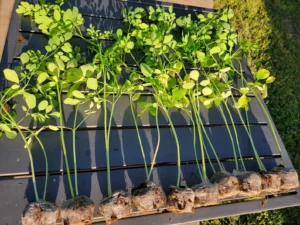Why Moringa Leaves Turn Yellow
Moringa, also known as the “miracle tree,” is a highly valued plant due to its numerous nutritional and medicinal benefits. It is widely cultivated in tropical and subtropical regions of the world, and its leaves are the most commonly consumed part of the plant. However, yellowing of Moringa leaves is a common problem that can adversely affect the growth and nutritional quality of the plant. As leaves are the main source of energy and nutrition for the plant, their yellowing can significantly reduce its yield and quality. In this article, we will explore the causes of yellowing Moringa leaves and provide solutions to this common problem. By identifying the causes and implementing the recommended solutions, you can ensure that your Moringa plant remains healthy and productive, providing you with a regular supply of nutritious and flavorful leaves.

Lack of Water
Moringa is a plant that requires consistent and adequate watering to thrive. The lack of water can cause yellowing of the leaves, as the plant becomes stressed and is unable to carry out its essential physiological functions. Signs of water deficiency in Moringa include dry and wilted leaves, and the veins of the leaves become more visible.
To prevent water stress in Moringa, it is essential to ensure that the plant receives adequate and consistent watering. The amount of water required depends on various factors such as temperature, humidity, soil type, and the stage of growth. Moringa plants require at least 1 inch of water per week. If the weather is hot and dry, the plants may require more water, and if it’s wet, the watering frequency should be reduced.
Watering should be done in the early morning or evening when the temperature is cooler to prevent water loss through evaporation. Deep watering is recommended to ensure that water reaches the plant’s roots, and the soil remains moist for an extended period. Applying mulch around the plant can also help to retain soil moisture and reduce water loss through evaporation.
In summary, ensuring that Moringa plants receive adequate and consistent watering is crucial in preventing yellowing of leaves due to water stress. Proper watering techniques, irrigation, and mulching are effective solutions for preventing water deficiency in Moringa plants. By implementing these solutions, you can maintain healthy and green leaves, which are essential for optimal growth and nutrition of the plant.

Nutrient Deficiency
Nutrient deficiency is another common cause of yellowing Moringa leaves. Nutrients such as nitrogen, iron, and potassium are essential for plant growth, and their deficiency can lead to reduced yield and poor quality of leaves. The symptoms of nutrient deficiency can vary depending on the nutrient lacking, but yellowing of leaves is a common symptom.
To prevent nutrient deficiency in Moringa plants, it is essential to maintain the proper nutrient balance in the soil. Soil testing can help to identify any nutrient deficiencies, and fertilizer can be applied accordingly. Moringa plants require a balanced fertilizer with equal amounts of nitrogen, phosphorus, and potassium.
Organic fertilizers such as compost or manure are excellent sources of nutrients for Moringa plants. Applying compost around the base of the plant can also help to improve the soil’s nutrient content. Companion planting is another effective solution for preventing nutrient deficiency in Moringa plants. Planting nitrogen-fixing crops such as beans and peas alongside Moringa can help to boost the soil’s nitrogen content.
Maintaining a proper nutrient balance in the soil is crucial for preventing yellowing of Moringa leaves due to nutrient deficiency. Soil testing, fertilization, composting, and companion planting are effective solutions for ensuring that Moringa plants receive the necessary nutrients for optimal growth and healthy leaves. By implementing these solutions, you can maintain healthy and green leaves, which are essential for optimal growth and nutrition of the plant.
Pest Infestation
Pest infestation is another common cause of yellowing Moringa leaves. Insects such as aphids, spider mites, and whiteflies can cause significant damage to Moringa plants, leading to yellowing and wilting of the leaves. These pests feed on the plant’s sap, causing dehydration and nutrient deficiency, which can result in yellowing of the leaves.
To prevent pest infestation, it is essential to maintain proper plant hygiene and take preventive measures. Regularly inspecting the plants for signs of infestation, and promptly treating any outbreaks is crucial. Insecticidal soap, neem oil, and other organic pest control methods can be used to control the pests without harming the plants.
Companion planting is another effective solution for preventing pest infestation in Moringa plants. Planting crops such as marigolds, basil, and mint alongside Moringa can help to repel pests and prevent infestation. Additionally, providing a conducive environment for beneficial insects such as ladybugs and lacewings can help to control pest populations.
Pest infestation can lead to yellowing of Moringa leaves and significant damage to the plant. Proper plant hygiene, regular inspection, and preventive measures such as companion planting and using organic pest control methods can help prevent infestation and maintain healthy and green leaves. By implementing these solutions, you can ensure that your Moringa plants remain productive and free from pests.

Disease
Disease is another common cause of yellowing Moringa leaves. Moringa plants are susceptible to various fungal and bacterial diseases that can cause yellowing and wilting of the leaves. Fungal diseases such as powdery mildew, leaf spot, and rust can cause discoloration and yellowing of the leaves, while bacterial diseases such as bacterial blight and canker can cause wilting and yellowing of the leaves.
To prevent disease in Moringa plants, it is essential to maintain proper plant hygiene and take preventive measures. Regularly inspecting the plants for signs of disease and promptly treating any outbreaks is crucial. Fungal diseases can be treated with fungicides, while bacterial diseases may require the removal of the affected parts of the plant.
Planting disease-resistant varieties of Moringa can also help to prevent disease. Proper irrigation and drainage, as well as avoiding overhead watering, can help to prevent the spread of disease. Removing and disposing of any infected plant material can also help to prevent the spread of disease.
Disease is a common cause of yellowing Moringa leaves, and proper plant hygiene, regular inspection, and preventive measures such as using fungicides, planting disease-resistant varieties, and proper irrigation and drainage can help prevent disease and maintain healthy and green leaves. By implementing these solutions, you can ensure that your Moringa plants remain productive and free from disease.
Climate and Environmental Factors
Climate and environmental factors can also cause yellowing of Moringa leaves. Moringa plants require warm temperatures and adequate sunlight to thrive. If the temperature is too low, or the plant is exposed to harsh environmental conditions such as strong winds, heavy rain, or extreme temperatures, the leaves may turn yellow and eventually fall off.
To prevent yellowing of Moringa leaves due to environmental factors, it is essential to provide the plant with the ideal growing conditions. Moringa plants thrive in well-drained, sandy loam soil, and require plenty of sunlight and warmth. Avoid planting Moringa in areas that are prone to flooding, as the excess water can cause root rot and yellowing of leaves.
Covering the plant with a light shade cloth during extreme weather conditions can also help to protect the plant from direct sunlight and excessive heat. Providing a windbreak or planting the Moringa in a sheltered location can also help to prevent damage from strong winds.
In summary, climate and environmental factors can cause yellowing of Moringa leaves, and it is essential to provide the plant with the ideal growing conditions to prevent this from happening. Providing well-drained soil, adequate sunlight, and protection from harsh environmental conditions can help to ensure that your Moringa plants remain healthy and produce green and vibrant leaves. By implementing these solutions, you can ensure that your Moringa plants thrive and provide optimal growth and nutrition.

Improper Pruning
Improper pruning is another common cause of yellowing Moringa leaves. Pruning is essential for maintaining the health and shape of the plant, but excessive or incorrect pruning can damage the plant and cause yellowing of the leaves. Over-pruning can lead to the removal of too many leaves, reducing the plant’s ability to produce energy through photosynthesis. Which can result in yellowing of the remaining leaves.
To prevent yellowing of Moringa leaves due to improper pruning, it is important to follow proper pruning techniques. Pruning should only be done during the plant’s dormant season. Also, only a small percentage of the plant should be removed at any given time. When pruning, it is essential to avoid cutting into the main stem or removing too many leaves, as this can harm the plant.
Proper pruning also involves removing any diseased, damaged, or dead branches or leaves to prevent the spread of disease and encourage new growth. It is also important to prune the plant to maintain its shape and size. As a plant that is too large can be difficult to manage and prone to yellowing.
Improper pruning is a common cause of yellowing Moringa leaves. It is important to follow proper pruning techniques to prevent this from happening. Only prune during the plant’s dormant season. Also, avoid cutting into the main stem or removing too many leaves, and remove any diseased, damaged, or dead branches or leaves. By implementing these solutions, you can ensure that your Moringa plants remain healthy and produce green and vibrant leaves.

Genetic Factors
Genetic factors can also play a role in causing yellowing Moringa leaves. Also, certain genetic disorders can cause yellowing of Moringa leaves, such as chlorosis. Which is a condition that affects the plant’s ability to produce chlorophyll, resulting in yellowing of the leaves.
Additionally, it is important to maintain optimal growing conditions and provide adequate nutrients to the plant. Regularly testing the soil for nutrient deficiencies and addressing any imbalances can help to prevent yellowing of the leaves due to genetic factors. In some cases, genetic disorders such as chlorosis may require specialized treatment or genetic modification to prevent yellowing of the leaves. Consultation with a plant specialist or geneticist may be necessary in these situations.
Conclusion
Moringa is a resilient and hardy plant that can provide numerous health benefits. However, yellowing of the leaves is a common issue that can be caused by a variety of factors. Including lack of water, nutrient deficiencies, pest infestation, disease, environmental factors, improper pruning, and genetic factors.
Preventing yellowing Moringa leaves involves identifying the specific cause and implementing appropriate solutions. Adequate watering, providing balanced nutrients, controlling pest infestation, addressing disease, maintaining optimal environmental conditions, and proper pruning can all help to prevent yellowing of the leaves.
It is important to note that yellowing of Moringa leaves can sometimes be an indication of a more significant issue with the plant’s overall health. If the yellowing persists despite efforts to address the specific causes outlined in this article. Consultation with a plant specialist or a horticulturist may be necessary.
Overall, by understanding the common causes of yellowing Moringa leaves and taking steps to prevent and address these issues. You can ensure that your Moringa plants remain healthy and produce vibrant and green leaves, providing a wealth of health benefits for you and your family.
References
- International Journal of Pharmaceutical Sciences and Research: https://ijpsr.com/bft-article/evaluation-of-antioxidant-activity-of-leaves-extract-of-moringa-concanensis-nimmo-on-isolated-frogs-heart/
Moringa With Barry stores offer a variety of moringa products. These include: Moringa Powder, Moringa Tea, Moringa Capsules and Moringa Oil.
Read more:
1. The Benefits of Moringa: Why It’s Good for You
2. 11 Compelling Reasons: Include Moringa in Your Daily Routine
3. Understanding Moringa: Exploring the Causes of Moringa Leaf Curl
4. Moringa’s Wonder for Women: Why It’s Beneficial
5. Unlocking Moringa’s Potential for Men: The Benefits Explained

